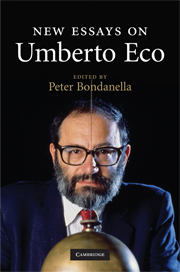Book contents
- Frontmatter
- Contents
- Notes on contributors
- Preface
- Acknowledgments
- 1 Eco and popular culture
- 2 Eco's semiotic theory
- 3 Eco's scientific imagination
- 4 From the Rose to the Flame: Ecos theory and fiction between the middle Ages and postmodernity
- 5 Eco's middle Ages and the historical novel
- 6 Eco and the tradition of the detective story
- 7 “The subject is in the adverbs.” The role of the subject in Eco's semiotics
- 8 Double coding memorabilia in The Mysterious Flame of Queen Loana
- 9 Eco and Joyce
- 10 Eco on film
- Selected bibliography on Eco
- Index
2 - Eco's semiotic theory
Published online by Cambridge University Press: 26 January 2010
- Frontmatter
- Contents
- Notes on contributors
- Preface
- Acknowledgments
- 1 Eco and popular culture
- 2 Eco's semiotic theory
- 3 Eco's scientific imagination
- 4 From the Rose to the Flame: Ecos theory and fiction between the middle Ages and postmodernity
- 5 Eco's middle Ages and the historical novel
- 6 Eco and the tradition of the detective story
- 7 “The subject is in the adverbs.” The role of the subject in Eco's semiotics
- 8 Double coding memorabilia in The Mysterious Flame of Queen Loana
- 9 Eco and Joyce
- 10 Eco on film
- Selected bibliography on Eco
- Index
Summary
The last pronouncement in Umberto Eco's fifty-year-long period of reflection on the processes of cognition and interpretation comes in the form of a novel, The Mysterious Flame of Queen Loana: An Illustrated Novel. Some readers of Eco see continuity between his first two novels (The Name of the Rose and Foucault's Pendulum) and the semiotic theory he produced up to that period in his career, while others argue that there is a discontinuity of sorts between his last three novels and his semiotic theory, or at least an expressive independence. It might be more useful in an attempt to understand the development of Eco's semiotic theory if we assume that after the publication of his third novel, The Island of the Day Before, in 1994, Eco entered a new phase of his reflection on semiotics that did not destroy the organic nature of the development of his work on this subject that had begun in 1975 with the publication of A Theory of Semiotics (Italian edition).
A number of reasons led Eco to write this general treatise. one of his preoccupations was the urgency to define the field, the methods, and most importantly the disciplinary boundaries of semiotic inquiry. Up to 1975, in books such as The Open Work, the frame of reference that Eco either accepted or criticized was structuralism and the theory of codes as it developed, beginning with the linguistic theory of Ferdinand de Saussure and Louis Hjemslev, and later modified in new ways by Roland Barthes.
- Type
- Chapter
- Information
- New Essays on Umberto Eco , pp. 17 - 33Publisher: Cambridge University PressPrint publication year: 2009
- 3
- Cited by



